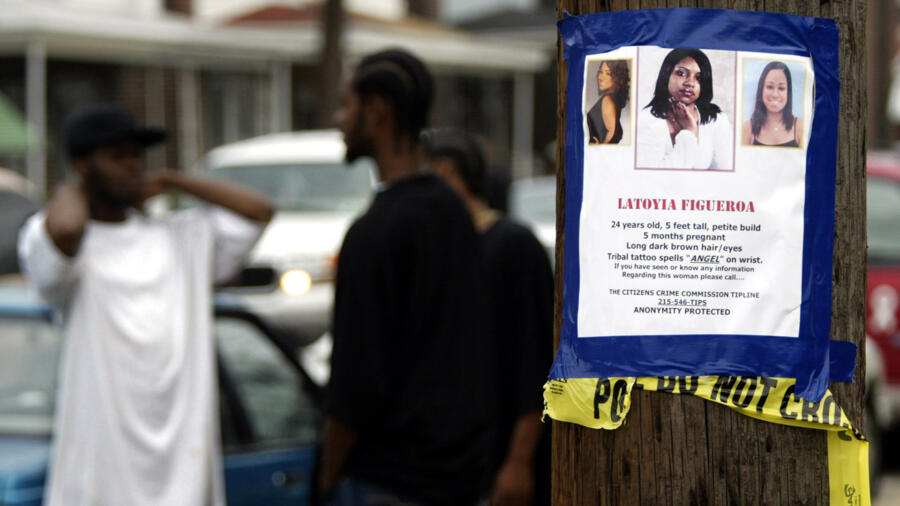More than 600,000 people go missing each year in the United States. Only a tiny fraction of those cases get media attention.
On July 18, 2005, 25-year-old LaToyia Figueroa disappeared in Philadelphia. The family alerted police when the young woman, who was pregnant with her second child, failed to pick up her daughter from daycare and then missed an evening shift at work. Police discovered her body about a month later in Chester, Pennsylvania. A judge found Stephen Poaches, the father of her unborn child, guilty of two counts of first-degree murder in the deaths of Figueroa and her fetus.
A “vivacious and forgiving spirit who touched the hearts of those who knew her” is how those closest to Figueroa described the young mother, who was raised by maternal relatives after her own mother was slain when she was a toddler. Although she lived with the fear of meeting a similar demise, there was nothing more important to Figueroa than her own 7-year-old daughter. Figueroa participated in her high school choir and dreamed of one day becoming a nurse.
The disappearance of Figueroa, who was Black and Hispanic, sparked controversy when the case didn’t get the attention it deserved in the media. Although her story closely resembled that of Laci Peterson—a pregnant white Modesto, California woman murdered by her husband Scott Peterson in 2002—the major networks paid little attention. Instead, they opted to heavily cover Natalee Holloway, a white American teen who had gone missing in Aruba a few months before Figueroa.
The Figueroa case typifies the phenomenon of the so-called “missing white woman syndrome,” in which the media tend to more often cover Caucasian women who have disappeared and to ignore stories involving people of color and men, as a whole.
Figueroa’s Disappearance
Figueroa attended a prenatal appointment with Poaches on July 18, 2005. After, they went to Poaches’ apartment. Figueroa was not seen or heard from again. Poaches told investigators that Figueroa had left his apartment “peaceably” around 5 p.m. and he did not know her whereabouts.
The family grew concerned when Figueroa didn’t pick up her daughter later that afternoon and then missed work. Both actions were out of character for the young mother.
“Toya was warmhearted and sassy. We would joke around with each other on shift,” L. William DeTurck, a former coworker at TGI Fridays, tells A&E True Crime. “She was a doting mom and always spoke about her little daughter and the love she had for her.”
Police spent several weeks investigating Poaches, but searches of his car and home produced no evidence of a crime. Investigators also pulled cell phone and credit card records and found no activity. Figueroa was then listed as a missing person. Unlike similar cases, including the disappearance of Peterson, who was eight months pregnant, Figueroa’s story did not immediately garner media attention.
Media Controversy and ‘Missing White Woman Syndrome’
Several weeks before Figueroa went missing, 18-year-old Holloway disappeared on the island of Aruba during a high school graduation trip. The media instantly became fixated on the Holloway story, covering every facet of the search efforts and sharing details of the case in hopes that the American teenager might be found alive. Figueroa’s disappearance, however, fell under the radar.
“The Holloway disappearance was getting all the press, while Toya was getting what the family could gather. I attended a rally in her neighborhood because the local news organizations were barely covering her story,” says DeTurck.
In 2004, late journalist and PBS news anchor Gwen Ifill first used the phrase “missing white woman syndrome.”
“White women tend to be overrepresented as victims in crime news stories,” Zach Sommers, an affiliated scholar at the American Bar Foundation, tells A&E True Crime. In a 2016 study, Sommers examined news coverage of missing persons. He found that the media give a disproportionate amount of news coverage to white women compared to women of color and men. Sommers cross-referenced the coverage of multiple news outlets with the FBI’s national database of missing persons and discovered that although white women only account for a third of the U.S. population, nearly 50 percent of the articles were about missing white women.
The FBI doesn’t break down missing persons information by race and gender combinations, making it difficult to compare how many Black women are missing relative to white women. We do know that of the more than 600,000 people reported missing in 2019, 359,768 were white and 205,802 were Black, but the FBI groups white and Hispanic numbers together, which is problematic when wanting to look at coverage comparisons.
The FBI estimates that the number of missing Black women and girls is around 64,000. According to an interview with Derrica and Natalie Wilson, the founders of the Black & Missing Foundation, that number doesn’t factor in those who were found or who left voluntarily, but caution that they’re “stilling seeing a spike in the number of women reported missing because of sex trafficking,” said Derrica.
While no scientific studies have been conducted to explain “missing white woman syndrome,” according to Sommers, some of the theorizings suggests the American public might be more willing to identify with white crime victims, since white people comprise a majority of the population, according to U.S. Census data.
“If we see a young white girl or white woman who’s gone missing, as [American] news consumers, maybe we are more inclined to say, ‘That could be my sister or my neighbor or my teacher,’ in a way that, unfortunately, it seems we’re less able or willing to do when it comes to people of color,” says Sommers. He also points out a monetization aspect of what we deem newsworthy and says it could reflect a social hierarchy that exists in the United States—and, more specifically, a systemic racial hierarchy that privileges white people.
While equitable coverage does matter, as it can help shape public opinion and garner more awareness of a case, there’s no scientific evidence suggesting that media attention helps solve crimes.
“There is a very limited body of research that suggests police investigation outcomes are affected by the amount of news coverage,” says Sommers. “Logically, it certainly makes sense that police departments are going to react dynamically to differing public relations pressures.”
The Figueroa case finally gained national media attention after a local blogger sent a letter to the major networks criticizing them for ignoring the story. In the meantime, Figueroa’s family led massive search efforts and philanthropists offered a $100,000 reward to help find her.
From Missing to Murdered
In early August 2005, police received a tip and followed Poaches to a wooded lot in Chester, about 13 miles from Philadelphia. There, authorities watched as Poaches attempted to relocate Figueroa’s body, ending a monthlong search and sparking a national debate about how the media handles cases involving missing people.
In a statement to police, Poaches said that when he and Figueroa returned to his apartment on July 18, 2005, they argued, and he began strangling Figueroa after he says she hit him in the face and shoulder.
“I kind of freaked out when she stopped hitting,” he told police. “She was dead. That was it.”
Investigators believe Poaches killed Figueroa after she refused to have an abortion. Poaches waived his right to a trial. On October 16, 2006, a judge found him guilty of two counts of first-degree murder and sentenced him to life in prison without the possibility of parole.
Poaches’ defense attorney argued that his client should have been charged with manslaughter, not murder, because he acted out of “sudden and intense passion” and not “malice, ill will or a hardness of heart.” Poaches remains incarcerated at the Pennsylvania State Correctional Institution.
Finding Light in Darkness
Since Figueroa’s disappearance and murder, Sommers observes more conversations happening around missing people of color, especially women of color, but stresses that we need more research to determine if there is a concerted effort to provide equitable media coverage.
“We are seeing an increase in the number of nonprofit organizations that are really dedicated to amplifying the voices of people of color who go missing and their family members or friends who are trying to shine a light on these cases,” says Sommers. “So, I think the conversation has continued to expand.”
Related Features:
How Chicago Is Trying to Solve 51 Strangulation Homicides of Women
Experts on the Twisted Reasons Why Some Husbands Kill Their Wives


